Pernille Ripp's Blog, page 17
September 2, 2019
Welcome to Our Classroom – A Tour Before the Kids Show Up
I moved to a new space this year. Still teaching 7th grade on the “O” team at Oregon Middle School, go Sharks! However, with the departure of one of my closests friends, her room opened up and I was allowed to move into what used to be the choir room (Choir now has a beautiful new space).
All summer, I have been tinkering with things. Trying to figure out the flow, the space, the needs of kids who I haven’t even met yet. And so while the room is as cleas as it will ever be, as organized as it will ever be, it is still not ready. it won’t be until the kids show up tomorrow – finally – and make it their own. They will get to move the furniture, find the spots that work, tweak the systems I have thought up and make it our space.
But until then, this is what our classroom looks like right now as it sits in suspense, waiting for the kids to show up.
So a few questions I get a lot are…
How do you have so many books?
It is a triple answer: My school district, Oregon School District, believes in funding books. Last year they gave us each $500 to buy more books. So some of the books come from them. Some of the books come from publishers who graciously send me books in order to consider them for the Global Read Aloud. If they send me an advanced review copy, I always purchase the book as well when it comes out to place it in my classroom collection.
And finally, I buy a lot of books. I wish it wasn’t that way, but it is, so I do. I spend too much money each year buying books for our students in order to help them have a better relationship with reading. Funding books does not seem like a priority in many places, and I don’t understand it, why wouldn’t we want all kids to have access to this many books in every classroom? If we can fund Chromebooks, then we can fund books. Pair this with a certified librarian running a fully-stocked library and you have the ultimate reading combination. All kids deserve to have this many books in their lives, not just those whose teachers spend their own money to do so.
Where do you get your books from?
I get many of my books from Books4School.com, a great warehouse here in Madison that sells overstock supplies of books for about $2 each. I also use my Scholastic money to buy books. I use our independent book store, A Room Of One’s Own, when we are downtown. I try to support my local Barnes and Noble as well because I don’t want them to go out of business, and I use Amazon. Sometimes the prices can’t be beat.
What are those ledges on the wall?
Built by Ryan, my friend’s husband, they are wooden ledges with a lip drilled into the wall. Now, you can also use rain gutters to display books. I had rain gutters below my whiteboard in my old classroom and loved having the extra display space. Another idea shared by someone (and if it’s you please let me know so I can give you credit!) was to have a bulletin board with books clipped onto it using larger binder clips tacked to the wall. That way kids can easily check out the books and you can easily replace them.
Where did you get the spinning rack?
I was handed it when I moved to OMS, however, you can order them online as well. Beware that it needs to have some sort of metal or solid base or it will not carry the weight of books, we discovered this the hard way last year when we purchased one with a plastic base. The spinning rack, while full right now, will be emptied within the next few days as students use it to recommend books to each other. When you place a book on the rack it is an automatic recommendation. I also use it to keep our “hot” books in circulation as they are returned.
One addition this year to our recommendation ideas is this stamp inspired by the stamp that Cassie Thomas shared on Twitter. I ordered mine from Amazon here and changed the wording slightly to just be the books I loved, I will be stamping books as I come across them in our library.
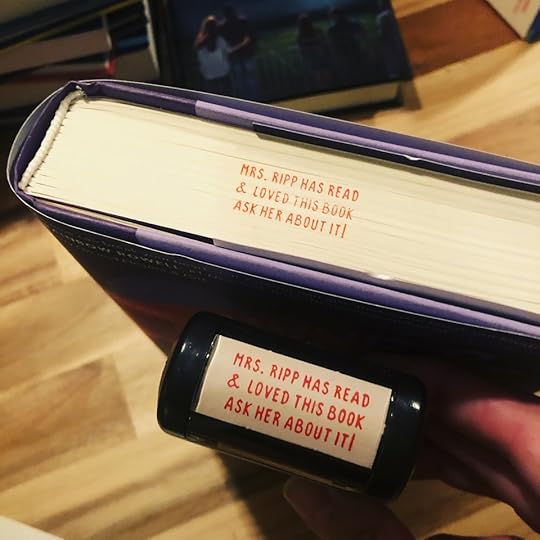
How do kids check out books?
Well, all books are stamped on the inside cover with a customized stamp I got from Amazon.

This helps books come back. If it is a softcover, kids just grab the books. If it is a hardcover, then they remove the dustcover, write their first and last name on a post-it, place it on the dustcover, and file the dustcover under their class section. Then they grab the book. When done, they reunite the dustcover with the book and place it in their return bin.
Where did you get your posters from?
The ones on the cabinets are from Amplifier.org and are from last year where my colleague, Katy, pointed them out to me. They offer incredible lessonplans to go with these posters. I am so excited for the coming year as well to see who they will focus on.
The @SonofBaldwin quote and poster that will ground our work was an image shared online that I blew up and ordered through Walgreens.
The Battlestar Galactica Happy Birthday Cylon poster is from Keyanna
The poster on the glass that says “You are just the child…” is one my husband designed for me, the file can be found here.
The poster “the only Reading Levels that Matter…” is created by Dev Petty and can be found here.
Which picture books do you have on display?
Right now, we have a lot of picture books on display that have to do with personal essay and identity. I wanted kids to see themselves potentially reflected in the picture books as we work to create a community.
I also have a few piles of books pulled for our writing process lessons, as well as our first day read aloud.
How are books organized?
Well, it changes depending on needs but mostly by genre and sub-genre. So books can have multiple designations and they have the abbreviation of the genre under the stamp on the inside cover. We don’t have a lot of author bins because kids asked me not to to do that in previous years.
Are there other questions?
I try to make the space functioning, welcoming, and flexible. I want the space to feel welcoming and safe for all kids. And I want the space to work for us, not for us to have to work to fit into the space. Yet, even though, I am know I am in an incredible space to start the year, it won’t matter if what we do doesn’t matter. Because while sharing my space is easy, doing the work is not.
And also, that we have an inequity in the US when it comes to funding for our schools. I am privileged that I get to work in a district where we have funding to have clean, inviting spaces. Every child deserves that and yet not every child gets that. Until we fix school funding, our system will continue to be horribly inequitable and not conducive nor safe for all kids. We have so much work to do.
This year will be another year for exploring our identity, for connecting with the world, for hopefully finding value in our time together. And that matters more than any piece of furniture or any poster I can put on the wall.
If you like what you read here, consider reading my newest book, Passionate Readers – The Art of Reaching and Engaging Every Child. This book focuses on the five keys we can implement into any reading community to strengthen student reading experiences, even within the 45 minute English block. If you are looking for solutions and ideas for how to re-engage all of your students consider reading my very first book Passionate Learners – How to Engage and Empower Your Students. Also, if you are wondering where I will be in the coming year or would like to have me speak, please see this page.
August 25, 2019
Happy 2 Years Passionate Readers
While I have a love-hate relationship with Facebook, one of the features I do love is the memories that it reminds me of. Often they are funny things my kids said or simply looking at their faces from when they were younger. But today, this popped up…
[image error]
A memory unlike many other – the birthday of my book, Passionate Readers, and probably one of the most nerve-racking moments professionally that I have ever had. After all, who knew whether this book which I poured my heart into, this book which my students were a part of as always, this book with its plea to continue to do the work that so many have done before me to create meaningful reading opportunities for all kids no matter their reading journey, was simply going to be worth anyone’s time?
Now, two years later, and looking back it is still incredible when someone tells me they have read the book. Especially when they are not related to me. That the ideas in it helped them support the work they were already doing, that it has helped others navigate the journey we all walk, and that it has helped me continue to learn more about the wonderful world of reading. I am so grateful.
So in order to celebrate the birthday, I would like to select two recipients to receive a copy of the book – either the Audible version or the print version. All you have to do is fill out this form and I will select two winners randomly Tuesday, August 27th. This contest is open to the world.
Thank you to all who found the book helpful, who have been a part of the Facebook group who have been a part of the book studies, the conversations, the work that has surrounded this book and its hope for all kids to feel that reading has some sort of value to them.
Fill in this form to enter to win.
August 17, 2019
My Favorite Back to School Picture Books for 2019
One of my favorite parts of our classroom is our use of picture books to create community, to settle into routines, to get to know each other, and so much more. This means I am always searching for great new picture books to share during those first few weeks and why not share those. Some of these are new, some are older, but here is a discussion of what I will be sharing and why.

We Don’t Eat Our Classmates by Ryan T. Higgins will be our first day read aloud (I think) because it is funny and also because we can talk about some expectations we may have when it comes to our community. When we can laugh a bit together, it helps ease some of the anxiety that there inevitably is wrapped up in the first (and sometimes many) days of school.
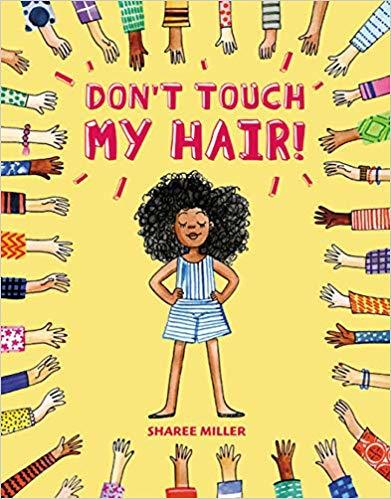
Consent is something I really want to weave throughout the year because there are so many aspects to it that impacts our students. That’s why we will use Don’t Touch My Hair by Sharee Miller to lead us into a conversation about consent as modeled by Elizabeth Kleinrock.
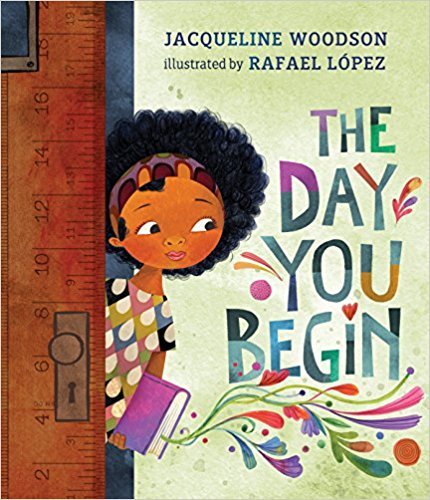
Being an immigrant and a child who moved a lot means that there were a lot of new days at schools. As we start our identity work, The Day You Begin by Jacqueline Woodson and Rafael Lopez is used as a mirror text for me, something that speaks to a part of my identity because I have the name teachers have to think about how to pronounce, because I didn’t speak the language, because I never knew who would sit with me and what they would think of my food.

I was so excited about the new Pigeon book to come out and this one is perfect for discussing emotions regarding going to school. In The Pigeon Has to Go to School by Mo Willems we get to see how Pigeon feels about going to school which may mirror the feelings of some of our students as well. This is, thus, a great conversation starter about how school makes us feel as we start to think about identity.

Independent reading is a cornerstone of our classroom and so using How to Read A Book by Kwame Alexander and illustrated by Melissa Sweet will fit perfectly in with the conversation about books and how they impact us both positively and perhaps even negatively. This will be the invitation into how we book shop.
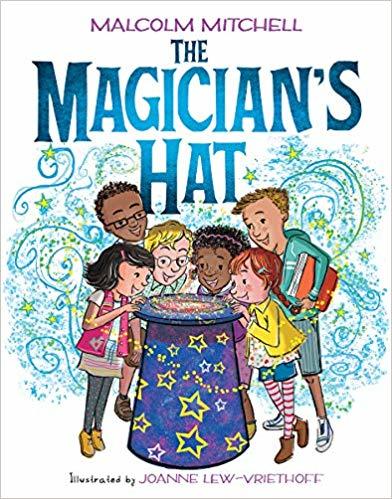
The story of football player and reader, Malcolm Mitchell, is one that I share every year with students and so reading his picture book The Magician’s Hat is the logical next step. It is always interesting to see a few kids start to let their guard down about reading books because of him.

Inquiry is at the heart of our year together in my plans, so I want to use Laura Vaccaro Seeger’s great new picture book Why to discuss what it means to pursue answers and ask many questions. I like how the book also shows that sometimes there are no answers but there always more questions.

Another picture book to use as we launch inquiry is Does it Fart: A Kid’s Guide to the Gas Animals Pass by Nick Caruso & Dani Rabaiotti illustrated by Alex G. Griffiths. This new picture book is a great way to show how a single question can offer a lot of information and how we can navigate all of that. It is also funny, which is a nice juxtaposition to some of the heavier work we will be doing.
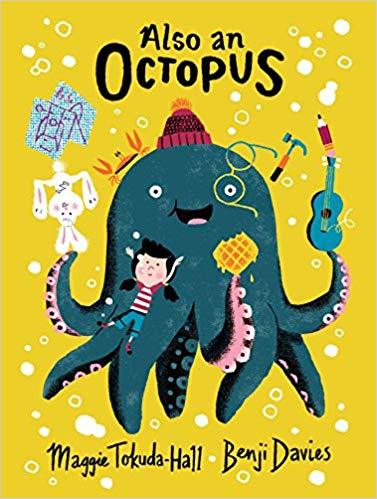
What do we need when we write? I may teach 7th graders but that doesn’t mean that they embrace writing or even know what to add in to their writing, so Also an Octopus by Maggie Tokuda-Hall and Benji Davis will be a great reminder to the writing process.
Because I haven’t met my students, this is a tentative list. A few of these I will for sure use, some I may or may not, and then are many others that I may use after I meet the kids. There are so many amazing ways to start a conversation, courtesy of the picture books that are created. I cannot wait to uncover which ones we need.
And then we launch into Memoir and Personal Essays where the books I am sharing are on a another list that can be found right here.
If you like what you read here, consider reading my newest book, Passionate Readers – The Art of Reaching and Engaging Every Child. This book focuses on the five keys we can implement into any reading community to strengthen student reading experiences, even within the 45 minute English block. If you are looking for solutions and ideas for how to re-engage all of your students consider reading my very first book Passionate Learners – How to Engage and Empower Your Students. Also, if you are wondering where I will be in the coming year or would like to have me speak, please see this page.
August 12, 2019
A Few Ideas for the New Year That I Am Trying
Every year, a few new ideas surface over summer that I just cannot wait to try. A few ideas that make me even more excited for the kids to come, if that was even possible. These ideas are not tried and tested yet, how can they be since summer still beckons, but I thought I would share them anyway in case they are ideas that maybe others want to explore as well? Or perhaps you want to share some of your own ideas as well? Either way, here are a few things happening in my head and in our classroom, room 203.
Ready-Set-Go conferences. These conferences are nothing new, but I have never done them at the middle school level. The concept is simple; offer up a 15 minute time slot ( or longer if you can) to every family that would like to meet with us before the year starts in order to give us a sneak peek into their child’s hopes and dreams. This is not for us to talk, but for us to listen as we meet the families that will be impacted by their child’s school experience with us. I also am pondering offering up “open office” time at a local coffeeshop for those who do not want to go into the school – thank you, Mindy, for that idea. I cannot wait to see how many are able and want to take this opportunity.
First writing unit is all about writing identity. While I do a lot of work with the kids surrounding reading identity, our exploration into who we are as writers has been piecemeal in the past few years. Not this year, our entire first exploration is an inquiry into who they are as writers, being mindful of privacy and how comfortable they are sharing anything, and picking up their journey wherever they are. This will center around personal essays/memoir and also feature a portfolio rather than one finished product. We will go slow, and hopefully, develop trust for writing instruction to truly be centered around not just the needs of each child but also how they hope to grow. And, it will take the time it takes.
Writing Circles. I was thrilled when I learned about the use of writing circles as a way to develop authentic writing partnerships in the book Comprehension & Collaboration by Stephanie Harvey and Harvey “Smokey” Daniels. Now, I want to implement this great idea into our writing throughout the year. Centered on the same concepts as literature circles, writing circles offers each child a unique opportunity to write with others around the same topic, or in the same format, writing alongside each other offering up critique and feedback throughout the process. This is trust based and so the students will get to select their first writing circles to see how they work for them and then I will help them adjust as we go. I am hoping this will provide students with a more natural collaborative group throughout the year that can help them grow as writers, rather than only having a few opportunities throughout the year to work with others. I will probably write more about this as I go.
Pairing book talks with author videos. Every day for the first month, I do a very short book talk every day in the hope that students will find great books to read. (After the first month, students start to do them as well, but they continue all year). This year, after our quick book talk, I will show a short video of the author speaking about the book, their writing process, or just being interviewed in general. This will serve a few purposes; students will see what the creators look like and hopefully connect with their work on a deeper level, seeing authors speak about their books can generate further excitement, and also, representation matters. When I am searching for author videos, Youtube or TeachingBooks.net are great places to start, I am further reminding myself that we should be highlighting the works of underrepresented authors and creators. With older works, I will search for audio recordings.
Supplies for all. I have always had extra supplies ready for kids, but in the past they had to ask for them because I didn’t really have space for them anywhere. Not this year, after heading to the Dollar Store, I am ready with several hundreds of pencils, erasers, post-its, markers, glue etc and they will be set out for the students to just grab when they need. No more needing to ask the teacher, just get what you need, bring it back if you remember, and then get to work. Most kids won’t need them, some will need them a lot, and others will need them once in a while and I am okay with that.
Group writing. We offer up a free writing prompt every day at the end of class, so that kids get a chance to either work on writing of their choice or do the prompt displayed, this is a way for them to continue to develop their writing and also dive into topics that they want to write about. This year, I am purposefully adding in opportunities to write as a group on Friday’s, I am hoping this practice will strengthen their writing circles as well as they will create together. (Writing will take many forms – acting out, drawing, and other multi-media expressions will also be included).
Incorporating an often overlooked history focus. I used to do a meme a day on our morning slide, which most of the kids found mildly amusing, but realized that the morning slide that greets kids is yet another opportunity to highlight the important work of historical figures that may have been overlooked in some of their lives until now. So every day, along with my welcome, will be a historical fact that abut an event or a person that they may not already know. On Fridays, we are also incorporating a small segment called Overlooked History where I use videos to start a discussion about historical events and people such as the Doctrine of Discovery, The Navajo Code Talkers, Henrietta Lacks, Japanese Internment Camps and many others.
While there are many more ideas being explored this year, these are just a few that I am slowly developing in order for them to feel naturally embedded into our classroom culture. I am hoping that this year, once again, is a year filled with questions, curiosity, and also work that means something beyond “just” reading and writing. I hope that what we do will matter more than just the grades, but time will truly tell.
If you like what you read here, consider reading my newest book, Passionate Readers – The Art of Reaching and Engaging Every Child. This book focuses on the five keys we can implement into any reading community to strengthen student reading experiences, even within the 45 minute English block. If you are looking for solutions and ideas for how to re-engage all of your students consider reading my very first book Passionate Learners – How to Engage and Empower Your Students. Also, if you are wondering where I will be in the coming year or would like to have me speak, please see this page.
August 10, 2019
10 Upcoming Picture Books I Cannot Wait to Read Aloud #PB10for10
I wanted to publish my post about the picture books I plan on using with my students at the beginning of the year, but I don’t have 10 selected yet, not even close, I have 4, because I haven’t met the kids yet and so I don’t know which books we will need just yet. So instead, I thought I would throw a spotlight on a few picture books that I am so excited are coming into this world. These are the ones I have pre-ordered so I will not miss them when they are published. Perhaps you have heard about them too or not, but here they are in random order.
 I am Perfectly Designed by Karamo Brown, Jason “Rachel” Brown and illustrated by Anoosha Syed.
I am Perfectly Designed by Karamo Brown, Jason “Rachel” Brown and illustrated by Anoosha Syed.In this empowering ode to modern families, a boy and his father take a joyful walk through the city, discovering all the ways in which they are perfectly designed for each other.
Release date: November 5th, 2019
 Let’s Dance by Valerie Bolling and Illustrated by Maine Diaz
Let’s Dance by Valerie Bolling and Illustrated by Maine DiazTap, twirl, twist, spin! With musical, rhyming text, author Valerie Bolling shines a spotlight on dances from across the globe, while energetic art from Maine Diaz shows off all the moves and the diverse people who do them. From the cha cha of Cuba to the stepping of Ireland, kids will want to leap, dip, and zip along with the dances on the page!
Release Date: March 3, 2020
 Just Ask! Be Different, Be Brave, Be You by Sonia Sotomayor and illustrated by Rafael Lopez
Just Ask! Be Different, Be Brave, Be You by Sonia Sotomayor and illustrated by Rafael LopezFeeling different, especially as a kid, can be tough. But in the same
way that different types of plants and flowers make a garden more
beautiful and enjoyable, different types of people make our world more
vibrant and wonderful.
In Just Ask, United States Supreme Court Justice Sonia Sotomayor celebrates the different abilities kids (and people of all ages) have. Using her own experience as a child who was diagnosed with diabetes, Justice Sotomayor writes about children with all sorts of challenges–and looks at the special powers those kids have as well. As the kids work together to build a community garden, asking questions of each other along the way, this book encourages readers to do the same: When we come across someone who is different from us but we’re not sure why, all we have to do is Just Ask.
Release date: September 3rd, 2019
 Dancing Hands: How Teresa Carreno Played the Piano for President Lincoln by Margarita Engle and Rafael Lopez
Dancing Hands: How Teresa Carreno Played the Piano for President Lincoln by Margarita Engle and Rafael LopezAs a little girl, Teresa Carreño loved to let her hands dance across the beautiful keys of the piano. If she felt sad, music cheered her up, and when she was happy, the piano helped her share that joy. Soon she was writing her own songs and performing in grand cathedrals. Then a revolution in Venezuela forced her family to flee to the United States. Teresa felt lonely in this unfamiliar place, where few of the people she met spoke Spanish. Worst of all, there was fighting in her new home, too—the Civil War.
Still, Teresa kept playing, and soon she grew famous as the talented Piano Girl who could play anything from a folk song to a sonata. So famous, in fact, that President Abraham Lincoln wanted her to play at the White House! Yet with the country torn apart by war, could Teresa’s music bring comfort to those who needed it most?
Release date: August 27th, 2019
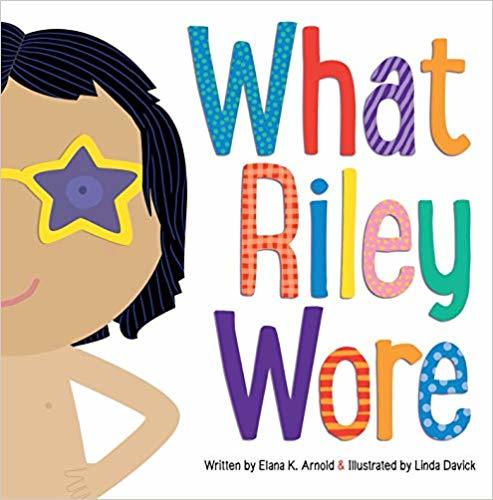 What Riley Wore by Elana K Arnold and illustrated by Linda Davick
What Riley Wore by Elana K Arnold and illustrated by Linda DavickRiley wears whatever clothes feel right each day. On Monday, Riley feels shy and wears a bunny costume to school. On Tuesday, a scary trip to the dentist calls for a super hero cape. For a trip out with Otto and Oma, a ball gown is the perfect outfit.
This charming picture book is a gentle exploration of self-expression and source of encouragement for being true to oneself despite the expectations of others.
Release date: August 27th, 2019
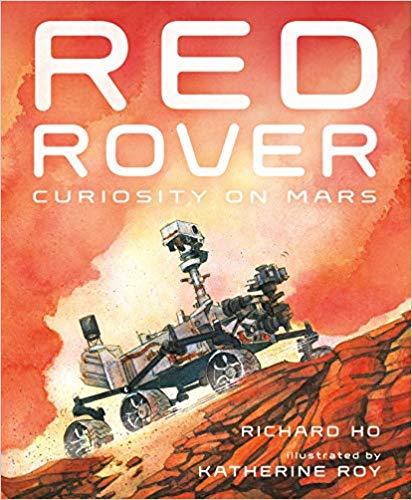 Red Rover: Curiosity on Mars by Richard Ho and illustrated by Katherine Roy
Red Rover: Curiosity on Mars by Richard Ho and illustrated by Katherine RoyMars has a visitor.
It likes to roam…
observe…
measure…
and collect.
It explores the red landscape―
crossing plains, climbing hills,
and tracing the bottoms of
craters―in search of water
and life.
It is not the first to visit Mars.
It will not be the last.
But it might be…
the most curious.
Release date: October 29th, 2019
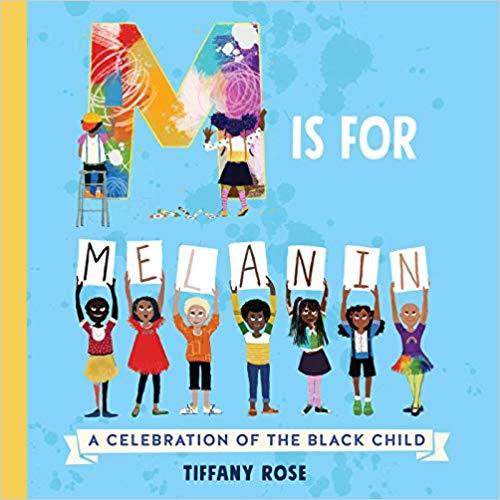 M is for Melanin: A Celebration of the Black Child by Tiffany Rose
M is for Melanin: A Celebration of the Black Child by Tiffany Rose
M is for Melanin
shining in every inch of your skin.
Every shade, every hue.
All beautiful and unique.
Each
letter of the alphabet contains affirming, Black-positive messages,
from A is for Afro, to F is for Fresh, to W is for Worthy. This book
teaches children their ABCs while encouraging them to love the skin that
they’re in.
Be bold. Be fearless. BE YOU.
Release date: October 1, 2019
 The Many Colors of Harpreet Singh by Supriya Kelkar and illustrated by Alea Marley and afterword by Simraan Jeet Singh
The Many Colors of Harpreet Singh by Supriya Kelkar and illustrated by Alea Marley and afterword by Simraan Jeet SinghHarpreet Singh has a different color for every mood and occasion, from pink for dancing to bhangra beats to red for courage. He especially takes care with his patka—his turban—smoothing it out and making sure it always matches his outfit. But when Harpreet’s mom finds a new job in a snowy city and they have to move, all he wants is to be invisible. Will he ever feel a happy sunny yellow again?
Release date: September 3, 2019
 Why? by Laura Vaccaro Seeger
Why? by Laura Vaccaro SeegerBear just wants to water his flowers, but Rabbit needs to know: why? Bear is looking forward to a peaceful night of stargazing, but all Rabbit cares about is: why?
As the two friends spend time together through spring, summer, and into fall, Rabbit persistently and simply asks Bear why, encouraging the reader to figure out for themselves the reason for each question that Bear patiently answers, over and over again. . . until there’s a question that he has no answer for.
Release date: August 13th, 2019
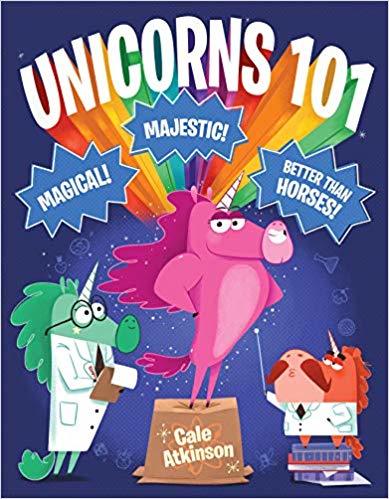 Unicorns 101 by Cale Atkinson
Unicorns 101 by Cale AtkinsonUnicorns! You love them, but how much do you really know about
them? Join Professors Glitter Pants, Sprinkle Steed, Star Hoof, and
Sugar Beard, plus their trusty lab assistant, Pete, as they reveal
mind-blowing unicorn facts never before available to the public! For
example:
* Buttercup Sparklecheeks was the first unicorn to trot on Pluto!
* At one time in history, there were dino-corns!
* One unicorn accidentally made it rain waffles for a week!
* Unicorns have giant slides inside their homes!
* Rare and exotic unicorns include the mer-corn and the hamster-corn!
Release date: September 3rd, 2019
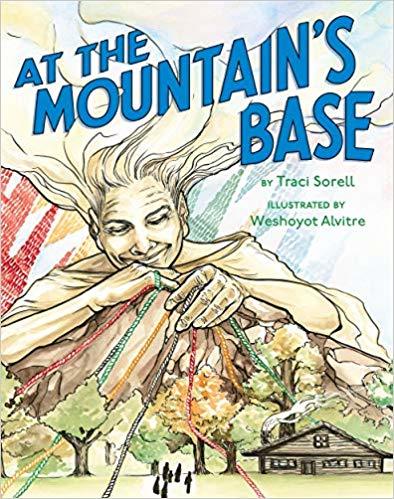 At the Mountain’s Base by Traci Sorell and illustrated by Weshoyot Alvitre
At the Mountain’s Base by Traci Sorell and illustrated by Weshoyot AlvitreAt the mountain’s base sits a cabin under an old hickory tree. And in that cabin lives a family — loving, weaving, cooking, and singing. The strength in their song sustains them through trials on the ground and in the sky, as they wait for their loved one, a pilot, to return from war.
With an author’s note that pays homage to the true history of Native American U.S. service members like WWII pilot Ola Mildred “Millie” Rexroat, this is a story that reveals the roots that ground us, the dreams that help us soar, and the people and traditions that hold us up.
Release date: September 17, 2019
 Rise! From Caged Bird to Poet of the People, Maya Angelou by Bethany Hegedus and illustrated by Tonya Engel
Rise! From Caged Bird to Poet of the People, Maya Angelou by Bethany Hegedus and illustrated by Tonya EngelWriter, activist, trolley car conductor, dancer, mother, and humanitarian Maya Angelou’s life was marked by transformation and perseverance. In this comprehensive picture-book biography geared towards older readers, Bethany Hegedus lyrically traces Maya’s life from her early days in Stamps, Arkansas through her work as a freedom fighter to her triumphant rise as a poet of the people.
Release date: August 13, 2019
 Gross as a Snot Otter by Jess Keating with illustrations by David DeGrand
Gross as a Snot Otter by Jess Keating with illustrations by David DeGrandThe creators of Pink Is for Blobfish are back, and they’ve brought 17 of their most revolting friends: there are slippery, slimy snot otters, gulls that projectile-vomit on command, fish that communicate via flatulence, and chipmunks that cultivate healthy forests by pooping a trail of seeds wherever they go. But there’s more to these skin-crawling creatures than meets the eye, and as zoologist Jess Keating explains, sometimes it’s the very things that make us gag that allow these animals to survive in the wild.
Release date: October 29th, 2019
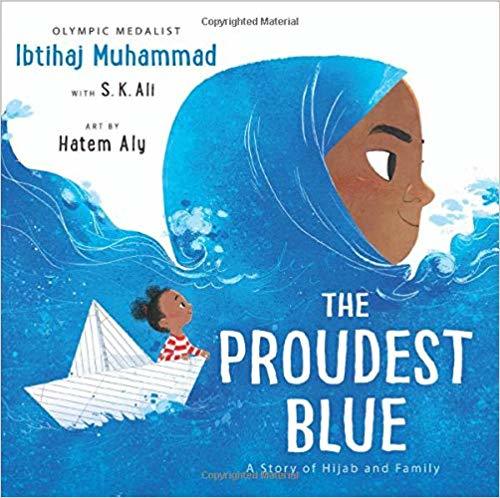 The Proudest Blue: A Story of Hijab and Family by Ibtihaj Muhammad with S.K. Ali and art by Hatem Aly
The Proudest Blue: A Story of Hijab and Family by Ibtihaj Muhammad with S.K. Ali and art by Hatem AlyWith her new backpack and light-up shoes, Faizah knows the first day of school is going to be special. It’s the start of a brand new year and, best of all, it’s her older sister Asiya’s first day of hijab–a hijab of beautiful blue fabric, like the ocean waving to the sky. But not everyone sees hijab as beautiful, and in the face of hurtful, confusing words, Faizah will find new ways to be strong.
Release date: September 10, 2019
Okay, so this is more than ten, but the truth is there are just so many great picture books coming out and I cannot wait to add them to our collection. These books should be read aloud, shared, and celebrated in any way we can.
August 9, 2019
On Posters and Welcome Displays
The post I wrote before this was really long and rambling, so much so that I got sick of writing it and instead decided to just get to the point. So here’s the point…
If you come to our room, and many people do, you will see this poster hang next to the door, in a prominent place where I hope every person sees it. This poster is my heart on display, but it also so much more.
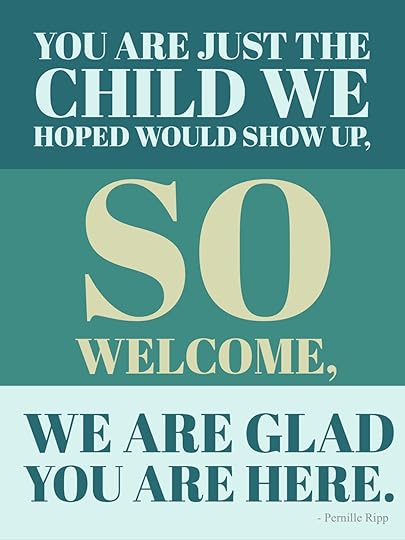
It is a promise.
A reminder.
A stern warning when needed.
And not to the kids, no, they barely glance at it, but to myself.
A promise to every child that walks in that day no matter their mood, no matter their temper, that in our space they will have space and I will do my best to value them.
A reminder to live the words I choose to share with the world, even when I am tired, frustrated, out of ideas.
And a stern warning to myself when my actions and reactions go against the very words I say I believe in. To stop. To breathe. To find love.
Because let’s face it, the display is easy to make but hard to live up to. Especially after the first few week’s excitement has worn off, especially once we settle into the every day routines, especially after the dust settles and we realize that we have so much to do and somehow we need to get doing it. Especially once we realize that we are, indeed, only humans with dreams and flaws that sometimes get in the way of success.
And so the poster hangs proudly as a reminder to myself to continue to reflect. To look at my own practice, to hold myself accountable even when others may think I am doing just fine. To use my voice to speak up, to try to make change, when so many inequitable practices still exists within the structures of school. To stick my neck out and fight for the kids who we don’t always fight for, even when I am the problem, even when my choices are the problem.
To remember that I cannot say that every child is welcome if the truth is far from it. That I cannot support the education of all children if the inequitable systems are not questioned, changed, broken. That I cannot pretend to be happy that these are the children that showed up if my pedagogical and psychological decisions don’t reflect that.
And so at the beginning of this brand new school year, with a classroom as ready as it can get for now, with all of these ideas in my head, with all of these hopes and dreams, I say this out loud so the universe knows; how will I live up to the words that I promise? How will you?
If you like what you read here, consider reading my newest book, Passionate Readers – The Art of Reaching and Engaging Every Child. This book focuses on the five keys we can implement into any reading community to strengthen student reading experiences, even within the 45 minute English block. If you are looking for solutions and ideas for how to re-engage all of your students consider reading my very first book Passionate Learners – How to Engage and Empower Your Students. Also, if you are wondering where I will be in the coming year or would like to have me speak, please see this page.
August 5, 2019
A Few Picture Books to Teach Memoir
We are starting the year, and the creation of our writing portfolio, with a unit focused on memoir and personal essay. I am hoping that in this unit, the students will start to share parts of their writing identity through discussion of what makes them a writer or not, the erules of writing and which we need to break, as well as experimentation with writing based in their own lives.
I have been gathering memoirs and personal essays for a while now, trying to focus on stories that may enrich their understanding of how others see the world so that they in turn can focus on their own lives.
As always, our trusted picture books are part of the mentor text collection that will surround students as we embark into this work, so here are the ones I have pulled so far that focus on small moments and written in 1st person. While some of these are true memoirs, others are texts I can use as models despite them not being true stories.
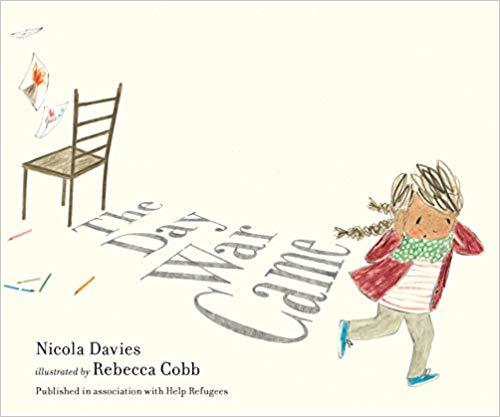 The Day War Came by Nicola Davies and illustrated by Rebecca Cobb
The Day War Came by Nicola Davies and illustrated by Rebecca Cobb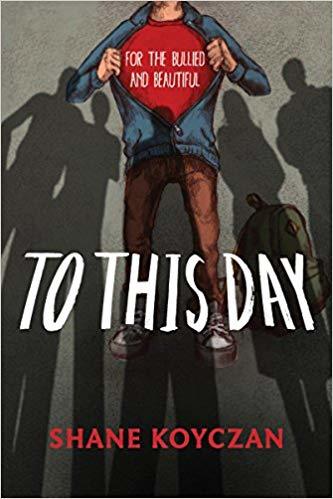 To This Day by Shane Koyczan
To This Day by Shane Koyczan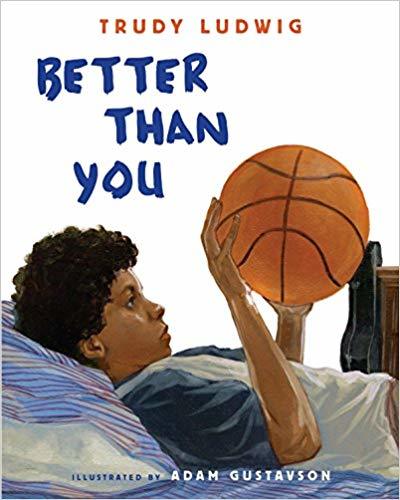 Better Than You by Trudy Ludwig
Better Than You by Trudy Ludwig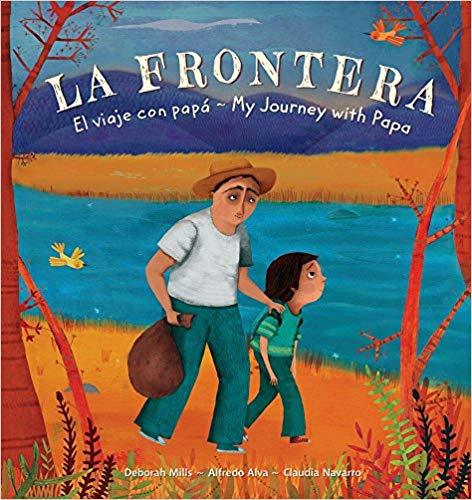 La Frontera – El Viaje con Papa’ – My Journey with Papa by Deborah Mills, Alfredo Alva, and Claudia Navarro
La Frontera – El Viaje con Papa’ – My Journey with Papa by Deborah Mills, Alfredo Alva, and Claudia Navarro The Bad Seed written by Jory John and illustrated by Pete Oswald
The Bad Seed written by Jory John and illustrated by Pete Oswald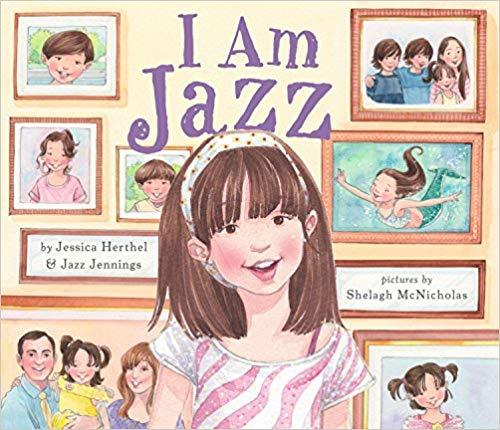 I am Jazz by Jessica Herthel and Jazz Jennings, pictures by Shelagh McNicholas
I am Jazz by Jessica Herthel and Jazz Jennings, pictures by Shelagh McNicholas
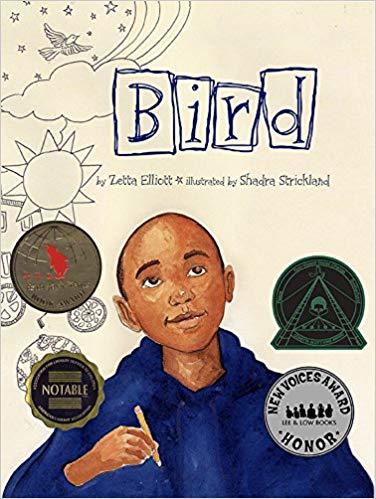 Bird by Zetta Elliott and illustrated by Shadra Strickland
Bird by Zetta Elliott and illustrated by Shadra Strickland I Love My Purse by Belle Demont and art by Sonja Wimmer
I Love My Purse by Belle Demont and art by Sonja Wimmer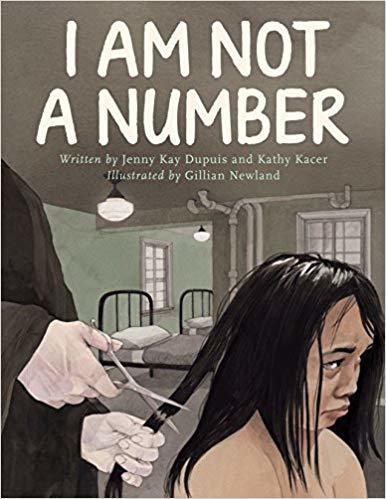 I Am Not a Number written Jenny Kay Dupuis and Kathy Kacer illustrated by Gillian Newland
I Am Not a Number written Jenny Kay Dupuis and Kathy Kacer illustrated by Gillian Newland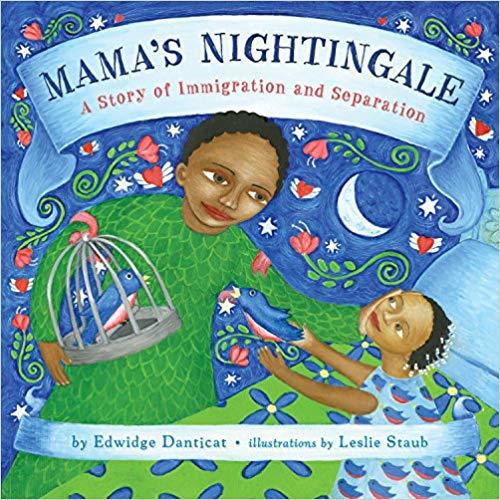 Mama’s Nightingale – A Story of Immigration and Separation by Edwidge Danticat and illustrated by Leslie Staub
Mama’s Nightingale – A Story of Immigration and Separation by Edwidge Danticat and illustrated by Leslie Staub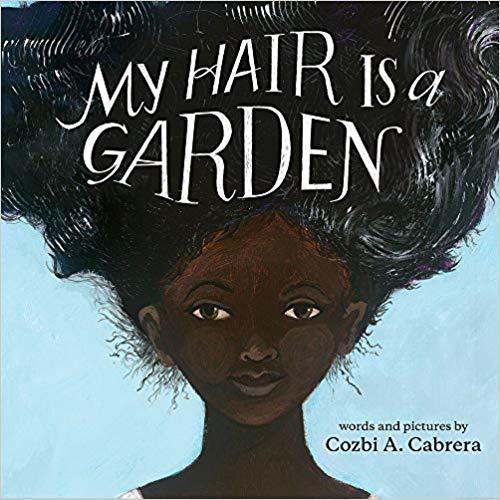 My Hair is a Garden by Cozbi A. Cabrera
My Hair is a Garden by Cozbi A. Cabrera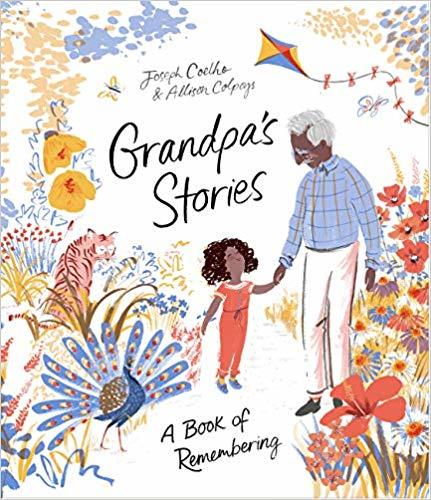 Grandpa’s Stories – A Book of Remembering by Joseph Coelho and Allison Colpoys
Grandpa’s Stories – A Book of Remembering by Joseph Coelho and Allison Colpoys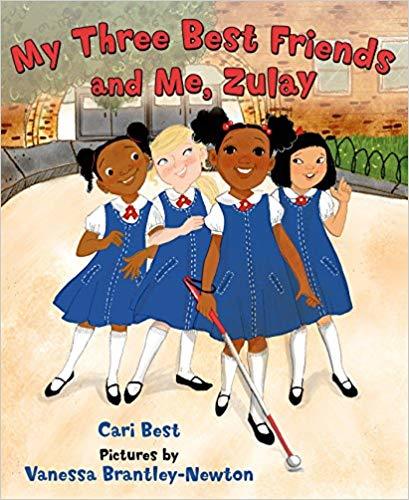 My Three Best Friends and Me, Zulay written by Cari Best and illustrated by Vanessa Brantley-Newton
My Three Best Friends and Me, Zulay written by Cari Best and illustrated by Vanessa Brantley-Newton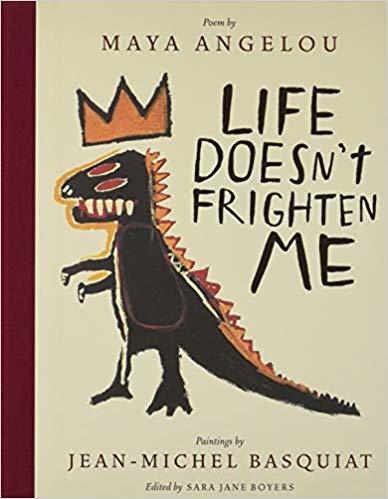 Life Doesn’t Frighten Me by Maya Angelou, paintings by Jean-Michel Basquiat and edited by Sara Jane Boyers
Life Doesn’t Frighten Me by Maya Angelou, paintings by Jean-Michel Basquiat and edited by Sara Jane Boyers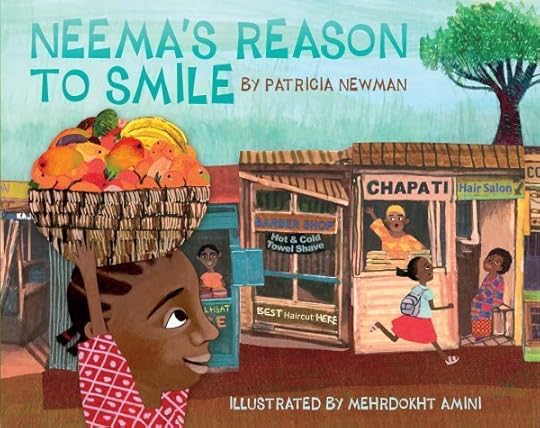 Neema’s Reason to Smile by Patricia Newman and illustrated by Mehrdokht Amini
Neema’s Reason to Smile by Patricia Newman and illustrated by Mehrdokht Amini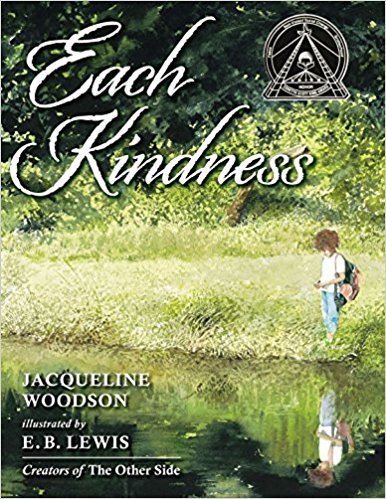 Each Kindness by Jacqueline Woodson and illustrated by E.B. Lewis
Each Kindness by Jacqueline Woodson and illustrated by E.B. Lewis Dad’s Camera by Ross Watkins and illustrated by Liz Anelli
Dad’s Camera by Ross Watkins and illustrated by Liz Anelli The Other Side by Jacqueline Woodson and illustrated by E.B. Lewis
The Other Side by Jacqueline Woodson and illustrated by E.B. Lewis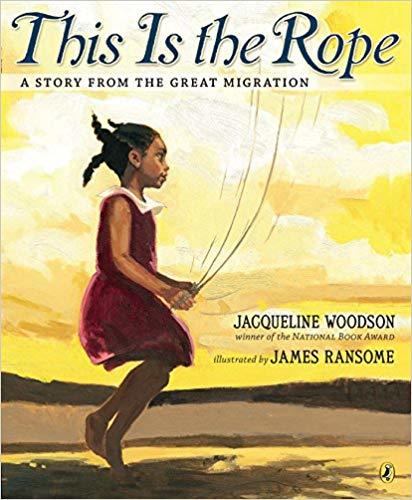 This is the Rope – A Story from the Great Migration by Jacqueline Woodson and illustrated by James Ransome
This is the Rope – A Story from the Great Migration by Jacqueline Woodson and illustrated by James Ransome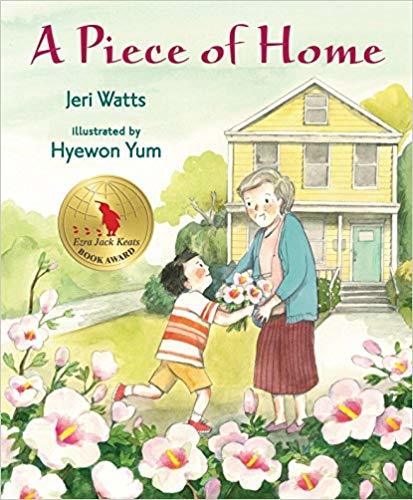 A Piece of Home by Jeri Watts and illustrated by Hyewon Yum
A Piece of Home by Jeri Watts and illustrated by Hyewon Yum The Remember Balloons by Jessie Olivieros and illustrated by Dana Wulfekotte
The Remember Balloons by Jessie Olivieros and illustrated by Dana Wulfekotte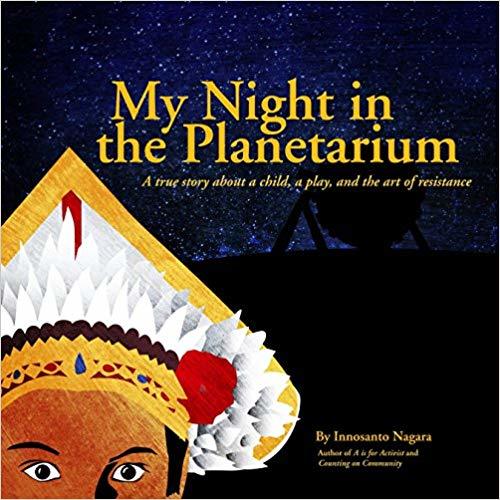 My Night in the Planetarium by Innosanto Nagara
My Night in the Planetarium by Innosanto NagaraI will add more as I pull them, especially newer books to use. If you would like to see other lists of favorite books, go here.
August 2, 2019
A Few Picture Books for Discussing the Writing Process
As I get ready to embark on another year of teaching English, I have been learning more about the writing process and the specific skills that I need to teach in order to help my students change or strengthen their experience with writing. Within the pages of professional development books I have found so much inspiration for how to create a better experience, hopefully, for kids. And so when I went to my classroom today, I pulled a few great picture books that I plan on sharing and showcasing to students to help them discuss the supposed rules of writing and how we can break them to create our a unique written piece. Here are some of the ones I pulled.

The Panda Problem by Deborah Underwood and illustrated by Hannah Marks is a newer picture book that breaks the fourth wall. While it tries to set up the problem of the story, panda quickly realizes that he is supposed to be the problem but he does not want to be.

Ideas are All Around by Philip C. Stead is a great book to share when someone tells you they have no ideas. Perhaps they need to take some time to look around and then see what they can come up with.
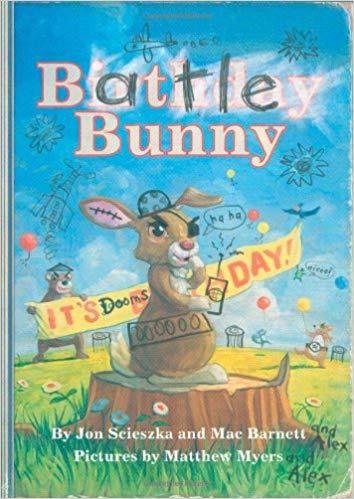
Battle Bunny by Jon Scieszka and Mac Barnett is a great picture book to use with kids that feel they have no ideas because it shows the legitimacy of starting from something known and making it your own. Plus, this book is just a fun read!
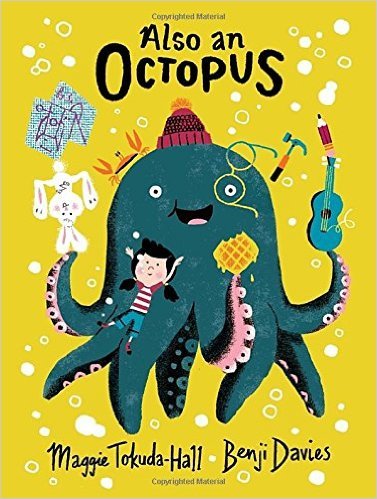
Also an Octopus by Maggie Tokuda-Hall and illustrated by Benji Davis is perfect for thinking of how we craft stories and the elements we need. The illustrations are playful and the story itself is informational and whimsical.
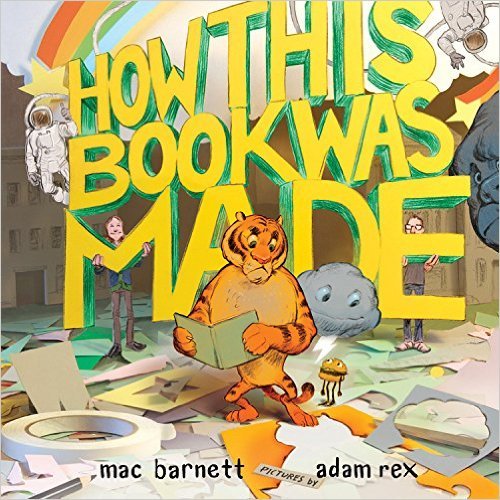
I wonder how many Mac Barnett books I have featured on this blog, his How This Book Was Made illustrated by Adam Rex is perfect for discussing writer’s and illustrator’s process. I am so thankful for their genius.
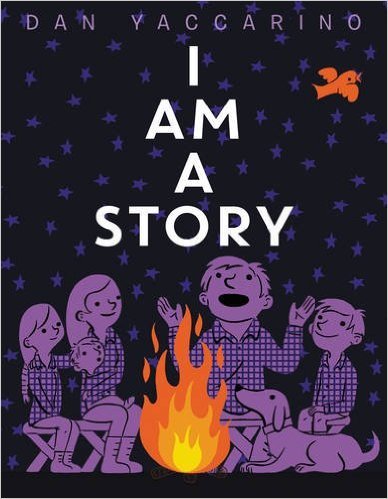
I love how I Am A Story by Dan Yaccarino urges us to think of how far stories have traveled and how they shape our society. I love the illustrations paired with the unfolding of story, fantastic for setting up writer’s workshop at any age.
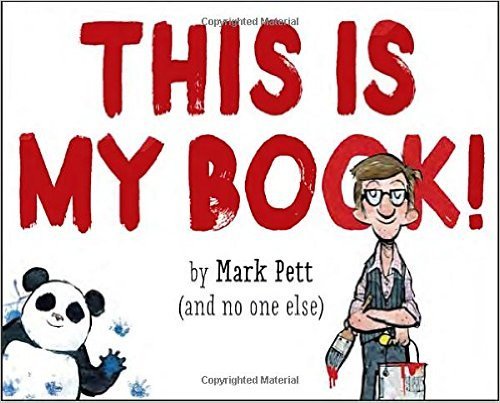
This Is My Book! by Mark Pett (and no one else) is laugh out loud funny. I especially enjoyed the interplay between the author and the panda. Kids are sure to appreciate the message but also how well it is portrayed; who really creates the story and how can we co-create?
[image error]
The Whisper by Pamela Zagarenski is beautiful both in text and in the illustrations. Using a book whose words fall out as a way to discuss imagination is a marvelous way to get students thinking more creatively.

In Little Red Writing by Joan Holub and illustrated by Melissa Sweet, we see how our pencil heroine has to navigate the perils of writing. relatable and wise, this is a great picture book.
Three PD books that are furthering my work at the moment are
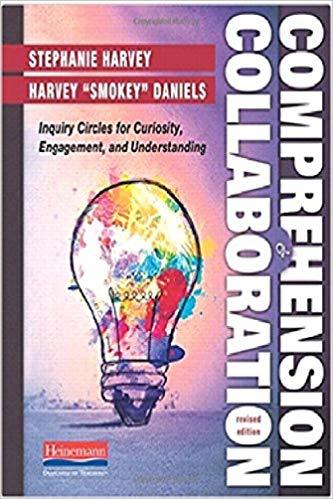
Comprehension & Collaboration – Revised Edition by Stephanie Harvey and Harvey “Smokey” Daniels is helping me frame our year of writing as inquiry explorations.
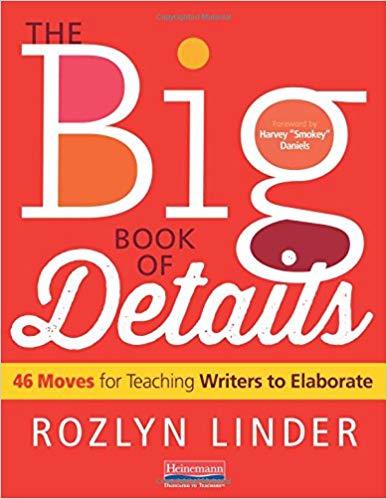
Rozlyn Linder left us much too soon but her genius lives on in her book The Big Book of Details. If you have ever told a child to add more details but wasn’t quite sure how to have them do this, this is the book for you.

The importance of Why They Can’t Write by John Warner to my upcoming year of instruction is undisputed. I am re-working everything I am doing with writing because of this book.
On Trigger Warnings and Potential Censorship
Warning: This post contains me changing my mind as well as unfinished thoughts. Read on to see what happens when you open your discussion to the expertise of others.
[image error]
You may have come across them if you read adult books. A list at the beginning of the book telling you what types of sensitive content you are about to be exposed to. A gentle reminder to take care of oneself, to breathe and step away if needed. To pay attention to the reading experience in more ways than understanding the text, but also understanding one’s own reaction to something in order to make an educated choice about the type of risk one is willing to take.
I usually skim over them but appreciate the gesture, but as I came across another one, it made me think; should our classroom and library books have trigger warnings? Should we as educators, librarians, add in potential trigger warnings in order for students to be more informed about the book they are about to pick up or not. It couldn’t hurt surely…
And yet, I wanted to think this out loud. What was I not seeing this discussed more because it seemed like such a simple idea. If it was so helpful, why wasn’t everyone doing it?
So I tweeted my thinking…
[image error]
[image error]
…and was not disappointed.
A few different discussion ensued; one about the language “trigger warning,” one about the placement of a potential sticker, and then also one about the problems with this practice.
On the language of using “trigger warning”
[image error]
[image error]
[image error]
[image error]
On the placement of the label on the front of the book
[image error]
[image error]
And most importantly on the whole concept
[image error]
[image error]
[image error]
[image error]
[image error]
So, as you can see, my thinking changed as others added their thoughts. It went like this…
Great idea, Pernille, get labels and make them colorful and bright so all kids can see them on the front of the books that discuss sexual abuse and violence, have racist language like the “N” word, feature violence against children and maybe other topics as well. Don’t call them trigger warnings – call them care and concern notes instead. Keep them on the front.Hmm, don’t put them on the front, put them on the inside instead.Wait, perhaps, it should just say “Come speak to me…”Hang on, what do I know about what will trigger a child?Will I end up needing to put a label on every single YA book in my room?Whoa, I may be encouraging censorship through this process.Whoa, I may be encouraging wider censorship of books through my original tweet sharing my idea.Where will the boundary be for what is considered a trigger? How will this look mixed in with hate/animosity towards marginalized populations?Someone may take my original idea and think to do this and end up demonizing marginalized people further.I need to write about this
And so, where does this take me?
Well, I still have a lot of thinking to do, but I know I won’t do trigger warnings. What I will do instead is many folded because the identities of our readers are complicated and nuanced.
I started by reading this article shared by my friend Sara Ralph and others
I will send home our classroom library letter at the beginning of the year in order for those at home to have an idea of what types of books their learners may encounter in our classroom.
When students are introduced to our classroom collection, I will specifically discuss how Young Adult books differ from middle grade and explain how I use the PG-13 rating on books.
I will book talk many of our tougher topic books so that students can hear me discuss some of the potential emotional parts in them so they can make the decisions that will work for them.
I will encourage, as always, that each child knows themselves well enough to know when to abandon a book.
I will confer as much as possible with my students about their book choices and whether they feel the book is great for them or not.
Books that have to do with suicide or sexual assault, I will place a label on the inside with help-line numbers.
And then I will continue to mull over the fine balance between helping kids find great books and hurting their choices instead.
The bottom line is; censorship lives and breathes in our collections of books. We already know that most of the challenged books as reported by ALA in the past few years have had to do with sexual and gender identity. We know that there are many active book challenges happening at this time. We know that sometimes through our well-meaning intentsion (like my original tweet) we may be furthering censorship. But the good news is that we don’t have to.
As a child growing up in Denmark, there was no censorship on the books I was encouraged to read. If I wanted to read about mature topics, I could, my mother trusted me to navigate these books when I was ready and then also let me know that at any point, we could discuss them. It fundamentally shaped my worldview today; that children know more than we assume, that we cannot shield them from tough things in the hopes of keeping them innocent, and that they are eager to learn about others.
By bringing this discussion online and now here, I encourage others to look at labeling systems that are already present in their schools, such as “mature” sections which only some kids can access, or books that need to be checked out with parent permission. Are these really helping kids or are we stopping them from reading books that will speak to them? That may be about them? That may give them hope? Do our “helpful” systems to shield children actually end up hurting them instead?
The kids show up in a month and one day, the books will be waiting. I cannot wait to see the stories they will gravitate toward, I will be there to help them.
Follow up: After posting this post, this incredibly thoughtful comment was left on it in a Facebook group it and brought to my attention. This once again shows me how much I still have to learn, despite being acutely aware of PTSD and how it can affect you.
P ernille Ripp you’ll be in our area at the end of this month, so I shared this post with our librarians, and one of them had this response. “I appreciated Pernille’s showcasing of dialogue and evolution of ideas on the topic. However, the origin of the trigger warning I feel is completely lost in the article. Trigger warnings are for people who have Post Traumatic Stress Disorder (PTSD). As someone who has PTSD and actually has to seek out signs for potential triggers when I engage in materials, trigger warnings are literally supposed to help prevent me, who has experienced trauma, from going into panic and/or fight or flight mode. Trigger warnings are not supposed to filter distressing topics. Those of us with PTSD are not distressed. We have a diagnosable condition where our brains are like broken records that when triggered can easily be stuck on repeat, reliving trauma over and over. When triggered we can forget where we are and who we are with, we can have a complete nervous break down, suffer insomnia, physical pain, lose consciousness, need medical intervention. This article did not seem at all to be dealing with actual triggers. Many of us experience trauma in a myriad of ways – and that can include reading material that covers topics discussed in the blog you shared because, let’s be honest here, reading is an empathetic experience. However, not all of us who experience trauma develop PTSD. My point here is: If a person needs trigger warnings, they need professional help.
I think the goal behind the conversation is valid and worthy of our time. However, the focus is misplaced. In order to properly label materials with warnings or care and concerns or whatever you want to call them, we would have to be well-equipped to understand what constitutes a trigger and then engage all our collection’s materials on a deep enough level to be able to properly label each and every one. That’s not a realistic goal. So instead of zeroing in on the materials themselves let’s focus efforts instead on making sure every library has a consistently updated and very visible and accessible: poster of hotlines and local resources, book collection, and series of programs designed to equip patrons with the tools they need to handle their pain/medical conditions. Let’s train every library staff member to recognize suicidal ideation in our patrons (a lot of times that stuff just leaks right out without them even knowing), how to talk to someone in crisis, and how to stay up to date on who to contact in an emergency. “
PS: THANK YOU so much to all who discussed this with me. To see the original tweet and thread go here
If you like what you read here, consider reading my newest book, Passionate Readers – The Art of Reaching and Engaging Every Child.
This book focuses on the five keys we can implement into any reading
community to strengthen student reading experiences, even within the 45
minute English block. If you are looking for solutions and ideas for
how to re-engage all of your students consider reading my very first
book Passionate Learners – How to Engage and Empower Your Students. Also, if you are wondering where I will be in the coming year or would like to have me speak, please see this page.
July 26, 2019
Why Writing Sucks and We Need to Talk About It
Six years ago, I wrote a piece on here called, Why Reading Sucks and It’s Ok to Talk About It. It has shaped my work ever since. It has become a defining feature of what I believe in when it comes to the work we help students do in our year of reading together. The need to focus on the emotions and experiences that a child carries with them when it comes to the act of reading, the need to validate them wherever they are on their journey in order to, hopefully, help them shape their journey in a more purposeful way. In order to protect those who love reading. In order to help those who hate reading perhaps dislike it a little bit less.
Much like that post, i try to teach kids to care about writing. To see their writing as something they can use beyond the lesson, beyond the product. I try to create situations where they find value in what they do and feel like they were actually taught something that perhaps will help them in their lives. Yet, every year, without a fail, no matter the amazing teaching and classrooms they have been a part of, so many of my students loudly proclaim how much they hate writing. And their actions show it.
“Forgetting” their pencils and not saying anything about it. Repeatedly telling me that they just don’t know what to write. Anger, shut downs, outright refusal. Quickly writing something in order to be done. Sometimes tears. And our students are not alone, often when I teach other teachers, I ask how many of them consider themselves readers – most raise their hand – when I ask themselves how many consider themselves writers, almost all of their hands go down. When I ask them to share a written reflection, you can see the pain behind that in many. And these are adults.
Writing is something that carries a lot of emotions. And we need to talk about that more.
And it needs to be direct, not hopefully something that comes up at some point, but a conversation that acknowledges that writing and the act of sharing one’s writing can be emotional for some, downright terrifying for others.
Because here’s the thing, if we say we want to create classrooms where students feel safe, where they feel accepted, where they feel that we care about them, all of them, then we need to make room for the complicated emotions that can be attached to the work we do. We need to make room for the identity of the writer that shares our space, not just the skills of the writers. And we need to do it purposefully. Not leave it to chance or hope that we will navigate it when it comes up. Think of how powerful it can be when we ask a child to share what they feel comfortable sharing before we dive into the work. When we set up the conditions to say, “It’s ok to not like writing, tell us more about that, so perhaps we can work on that together…” To acknowledge that some of our kids think they are bad writers because their spelling is not strong. That some of our kids think they are bad writers because their grades tell them so. That some of our kids think they are bad writers because they see no value in the types of writing we do, so why invest themselves?
To write something is to make yourself vulnerable to the world. It is to not only share your thoughts but to share them in a way that tells us when they are incomplete, when they perhaps are misspelled, when perhaps our grammar or way of speaking is different than others. It is to create a somewhat permanent record of who we are at that very moment. It is to let others into ourselves.
So as I plan for my first few days of school, one of the central conversations that will ground our identity work for the year will be, “When does writing suck?” I will share my own experiences as a writer in the hope that students will share some of theirs. Then I will hand them post-its; write down as many reasons you can think of for when writing sucks or for when writing is great. You don’t have to put down your name if you don’t want to. You can write to only one side of the experience. You can write down as many as you want. You can share as deeply as you want. Tape them to the board so they don’t fall down.
And then we will step back and look. See the patterns, discuss the patterns. We may see how others share the same thoughts as we do. We will decide on ways to move forward.
We will create our writing rights together, let these community agreements determine our path forward.
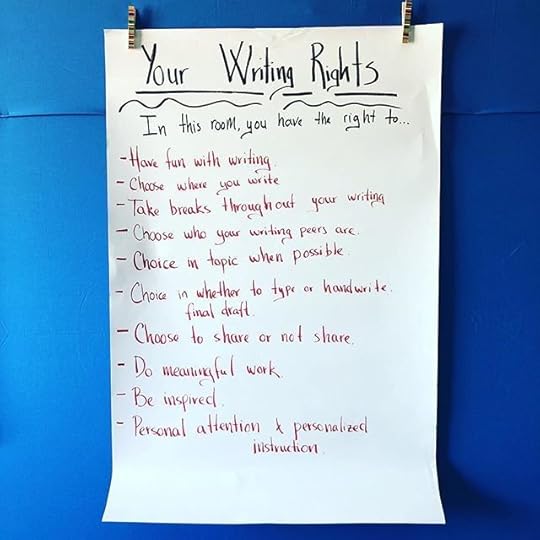 Our writing rights based off of last year’s discussion.
Our writing rights based off of last year’s discussion.I know this is only the beginning, a start that will work for some but not for all. I know that the students have no reason to trust me, yet some will. I know that with others it will take time, action, and courage. I can hope to create the conditions in our shared experience so that at some point, perhaps, writing will be something they don’t hate. Something they can see their own growth in. Something they can see value in. I can hope. But I can also plan.
PS: I just wrote about writing identity some more here.
If you like what you read here, consider reading my newest book, Passionate Readers – The Art of Reaching and Engaging Every Child. This book focuses on the five keys we can implement into any reading community to strengthen student reading experiences, even within the 45 minute English block. If you are looking for solutions and ideas for how to re-engage all of your students consider reading my very first book Passionate Learners – How to Engage and Empower Your Students. Also, if you are wondering where I will be in the coming year or would like to have me speak, please see this page.



